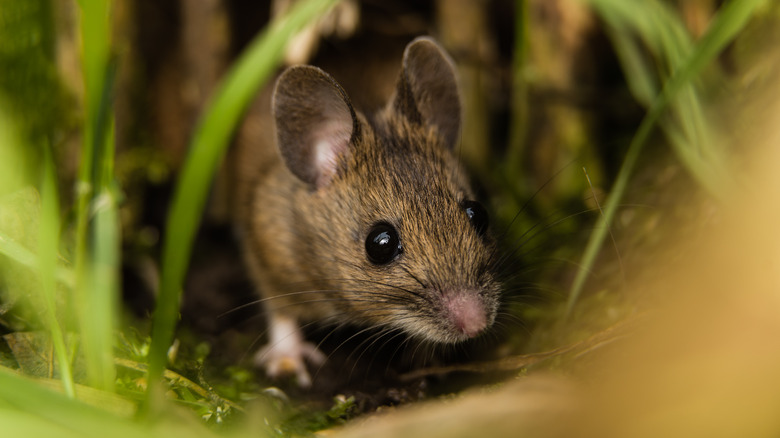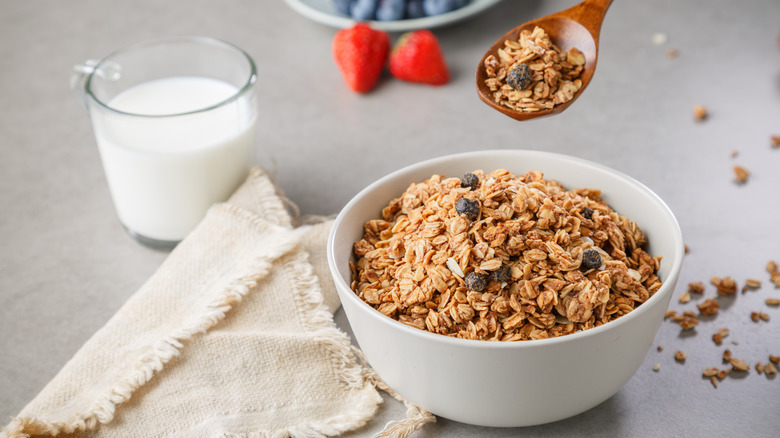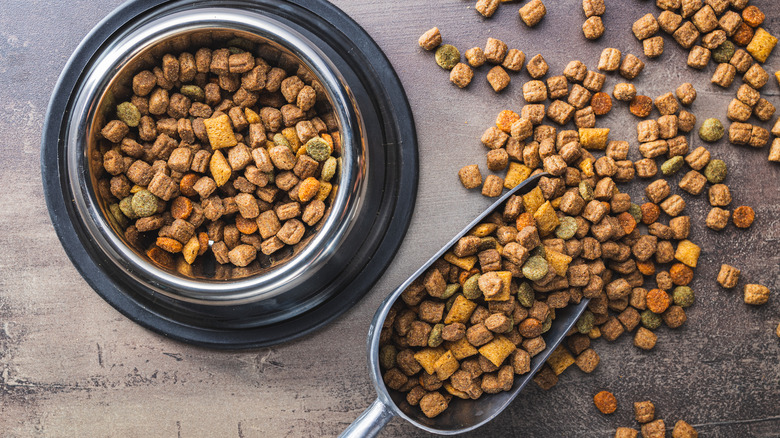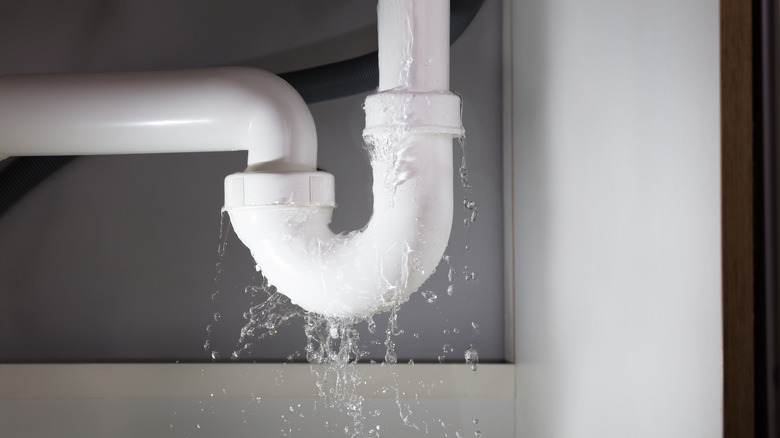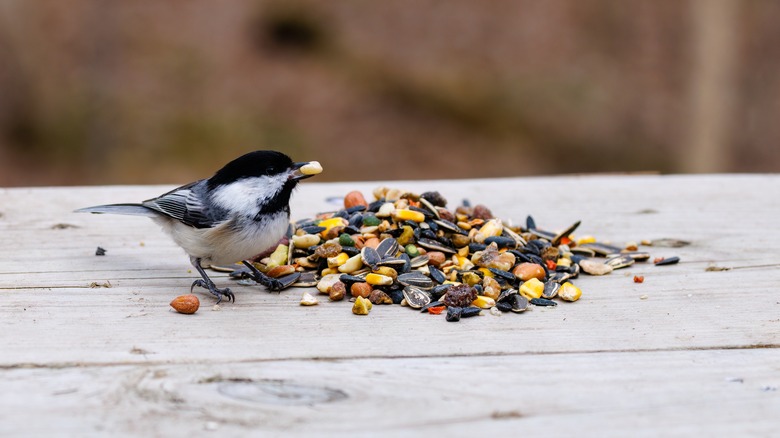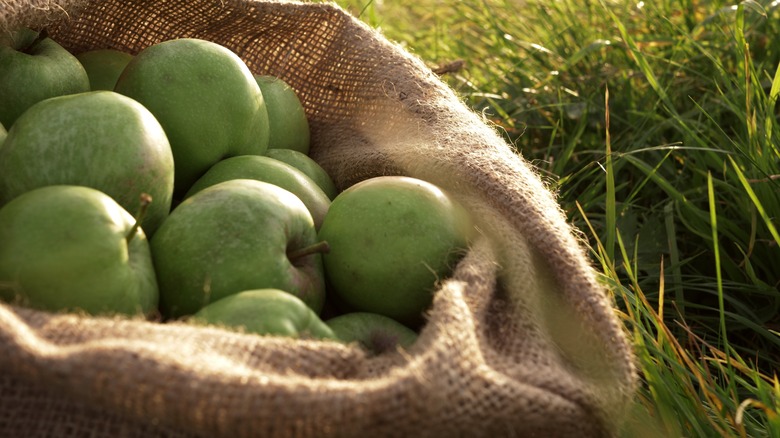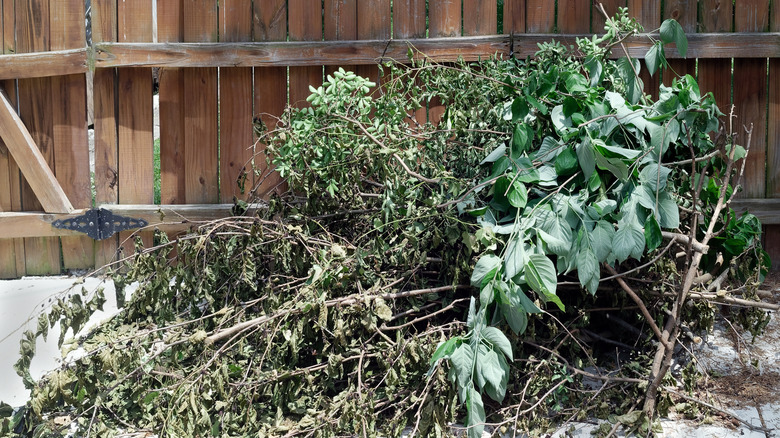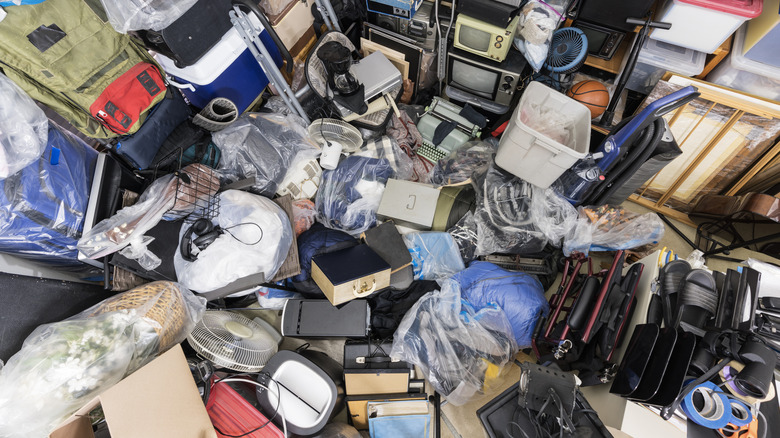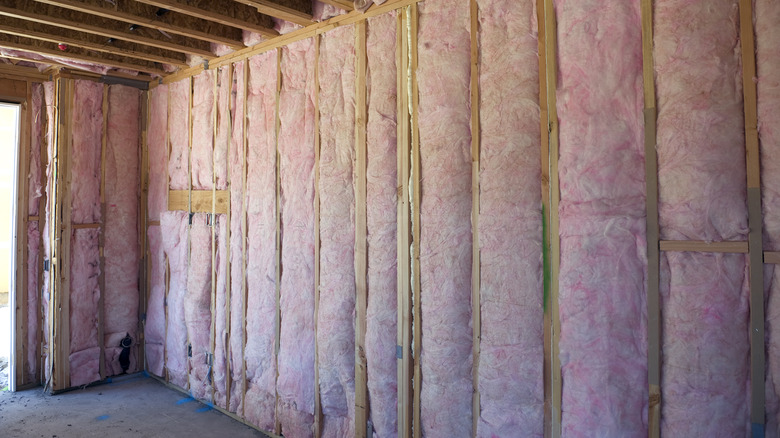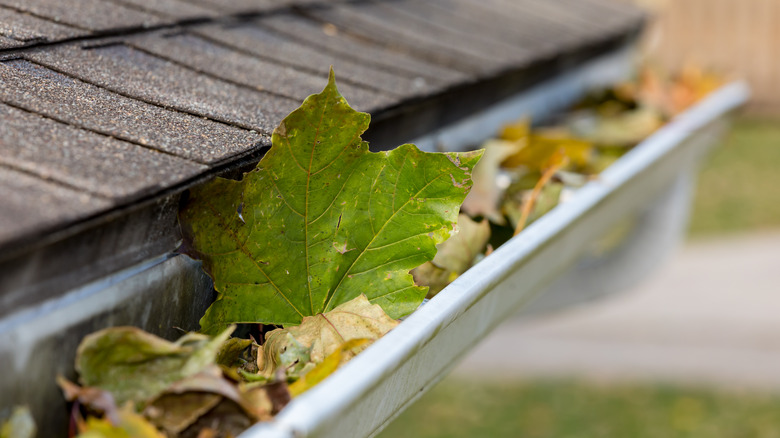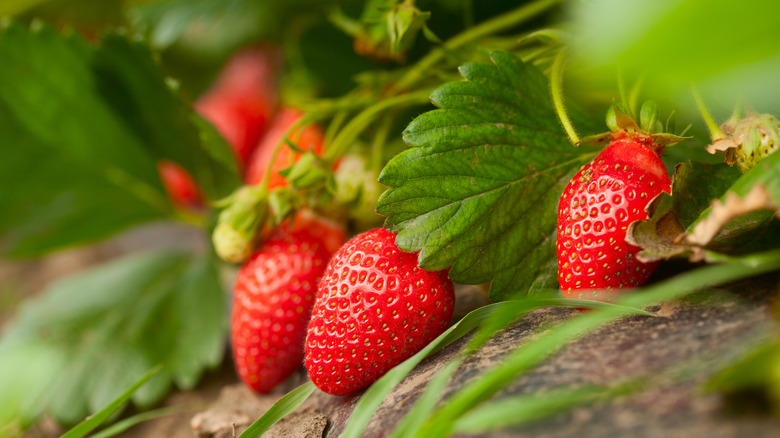11 Mistakes That Are Attracting Mice To Your Home & Garden
Although mice may be tiny and cute, they can be quite a nuisance when they make their way into your home or garden. Mice have been known to chew through electrical wiring, costing you money, as well as putting your home at risk of a fire. They also carry diseases like Salmonella and leptospirosis, which can be passed to humans and pets if contact is made with the rodent's urine or feces. Should you spot evidence of a mouse among your vegetables or within your dwelling, there's a good chance that you're making one or more mistakes that are attracting the furry creatures.
Mice will flock to any home for warmth and shelter during the cold winter months, and although there isn't much you can do about that other than seal the cracks around your foundation, there are a host of additional attractants that you can identify and correct. A few common missteps homeowners are accidentally making include leaving piles of debris in the yard for mice to use as shelter, setting pet food outside for mice to feast on, and not removing standing water that mice use for a refreshing drink. Addressing these common mistakes makes your home and garden less appealing to mice, mitigating the risk that they will take over your property, cause damage, and spread disease.
Leaving food items exposed
Mice will enter your home in search of food, and they aren't selective, so they will eat anything that you leave out. This includes cereal, peanut butter, fruit, bacon, chocolate, corn, and granola. In fact, the tiny creatures only need to consume about one ounce of food per day, so it's likely that they will munch on your food for a little bit, leave, and return again the next day for more. You'll need to take steps to secure the food to ensure it doesn't become contaminated by the mice, making it unsafe to eat.
To keep mice from being attracted to your kitchen, clean up all spills and crumbs soon after they happen. If you can't wash your dishes right away, make sure you give them a thorough rinse before letting them sit in your kitchen sink. Leftovers and open boxes of food should be transferred into sealable containers with reliable lids. Bags made of paper are not a good option, as mice are also known to consume paper. They will chew right through the bag to get to the goods. Consider purchasing plastic storage containers for items normally sold in paper boxes, such as pasta and cereal. These containers also serve as an excellent way to organize your pantry, so it's a win-win.
Leaving pet food out all day
Human food isn't the only attractant for mice. They also enjoy feasting on the meals you leave out for your cat or dog. According to Pest Pointers, pet food is filled with protein, grains, and fat, all of which mice love to eat. In fact, if you live on a larger property with additional animals, such as cattle, chickens, ducks, and horses, you're also making a mistake leaving their food out where mice could easily access it. Should the food become contaminated, you'll end up having to dump it, which could cost you a pretty penny.
To avoid this issue it is imperative that you never leave pet food outside. If you enjoy feeding strays, wait until they show up at the door before giving them food. As soon as they finish, bring the bowls inside and wash them. Indoor pets can be kept on a schedule, so that food dishes can quickly be removed and cleaned. Keep all of your pet food, including food for your farm animals, in containers with a tight seal. Plastic and metal are both excellent options, as long as the plastic is on the thicker side.
Providing access to water
Chances are you're providing mice with access to water without even realizing it. There are several ways mice can quench their thirst both on the inside and outside of your home. Just like with food, mice only require 1 ounce of water per day to continue to thrive, so even the smallest water source is a goldmine for these tiny creatures. Leaky pipes, moisture around sinks, spills, and standing water in your yard are all ways mice can satisfy their need for a drink.
Begin by inspecting your plumbing and fixing any leaks that you find. After doing dishes, grab a dish towel and wipe up the area around the sink and dishwasher. This will soak up any moisture that may be drawing the mice to your kitchen. Always address any spills as soon as you notice them as well. When it comes to lawn maintenance errors that are causing your mice problem, survey the yard and correct any spots that contain standing water. You may need to fill in a low-lying area with more soil or remove a bird bath. Outdoor buckets and upside-down trash can lids can also collect rainwater. Don't forget to inspect any outdoor faucets, garden hoses, and sprinklers for leaks as well. Fixing these issues will make the habitat less attractive to mice.
Providing bird or grass seeds as a meal
Another common mistake that is drawing mice to your yard is leaving out any type of seed, such as bird seed and grass seed. The seeds are additional food sources for the mice, as well as other pests, such as squirrels and racoons. If you love birdwatching, you can still entice the creatures of flight to visit your yard and garden, you'll just need to make a few adjustments to keep mice at bay.
Choose a location for your bird feeder that is at least eight feet away from the house or any nearby branches that could provide a bridge to the birdfeeder, advises the University of Nebraska-Lincoln Extension. Set up a six-foot pole to hang the bird feeder from, as mice will have trouble climbing up the pole to reach the seeds. Add a baffle about four feet up for extra protection. Store bags of bird and grass seed in sealable plastic or metal storage containers, versus keeping them in a storeroom in their original bags. Always clean up any seed spills as soon as you spot them, including those that the birds may knock out of the feeder.
Allowing grass to grow tall
A habitat that is attractive to mice also includes shelter. It's a mistake to allow your grass to grow tall before mowing it, as the added height provides mice with the cover they seek. The rodents will use this cover to make their way over to your home, where they will search for a way to gain entry. Fortunately, correcting this blunder is quite simple, and just requires a little bit of time and dedication.
Create and stick to a mowing schedule to keep your grass from becoming too tall. The University of Florida IFAS Extension points out that a well-manicured lawn will not only eliminate the cover that mice seek, but it will also inadvertently keep other predators, such as snakes, from taking up residence in your backyard. If weeds are shooting up higher than your grass, you can administer an herbicide according to the product label for better control.
Leaving out nesting materials
Once temperatures begin to drop and mice make their way into your home for shelter, they will begin searching for nesting materials. The nest will add a layer of warmth, especially if the rodents choose to set up shop in your damp basement. Leaving out materials mice can use to construct their nests is a mistake. A few of these items include cloth, burlap, and any type of paper goods.
Begin organizing and storing all of your fabric, burlap, and paper goods inside sealable plastic containers. Larger totes work well for this. If the totes aren't translucent, you'll want to stick a label on the front for easy identification. To add another layer of protection, create a repellent that will deter mice from visiting the area. Tomcat recommends soaking cotton balls in peppermint essential oil. Place the cotton balls around the rooms you want to remain rodent-free.
Allowing debris to pile up in the yard
Life gets busy and before you know it you have a yard full of debris in need of some serious attention. It's a mistake to wait to tackle yard debris, as mice use it for both shelter and nesting materials. Wood piles are a prime location for mice to camp out, while brush piles offer plenty of nesting supplies. Rock piles, as well as overgrown trees, ivy, and bushes are also sources of shelter and nesting materials.
Trim back trees, bushes, and ivy, especially around the perimeter of your home. Rake and bag fallen leaves to keep mice from using them to create a nest. Raise stacks of firewood by placing the logs on a pallet. It's best to keep the firewood at a distance of at least 30 feet from your home. Take apart any rock piles and then get rid of any brush piles. You can use some of the sticks from the brush piles in your fireplace or place them in a bonfire.
Allowing clutter to accumulate within a home
Just like with debris piles outdoors, clutter indoors offers mice a place to hide. Many of the items within your clutter heap can also be used as nesting materials, so it's a big mistake to put off organizing your home. Additionally, a mound of clutter may hide evidence of a mice infestation, leaving you completely unaware that you have a problem.
Start tackling the clutter in your basement and attic. Organize and store your belongings in plastic containers, making sure not to stack them directly on the floor or near a wall. When it comes to clothing, you'll want to hang as many items as you can and place the rest in a dresser drawer or storage tote. Use a hamper with a lid for soiled clothing. Move on to the other rooms in your home, placing any item that could be used as nesting material in an air-tight container. If the prospect of managing the clutter by yourself seems overwhelming, there are professional organizers who can come in and help for a fee.
Not fixing exposed insulation
Whether you're in the middle of a home remodel or you have repairs that need to be made, it's never a good idea to leave insulation exposed. Mice use insulation for nesting materials, as it provides extra warmth on those cold winter nights. Some mice won't even bother taking your insulation and moving it to a nesting spot. They will simply burrow in the existing insulation and call it a night.
To keep mice from visiting your insulation, make all repairs in a timely manner. Cover over the insulation if you can't get to the repairs right away. In the event that mice have already found the insulation, as evidenced by droppings or loose pieces of material, you can swap out the traditional rolls of insulation for a sprayable foam insulation. Mice won't be able to use the sprayable foam as a place to nest. Of course, swapping out the materials will come at an added cost.
Allowing gutters to become and remain clogged
Once autumn arrives, tree leaves begin to die off and fall to the ground to prepare for the coming winter. Not all of the leaves make it to ground, however. Overhanging trees may leave piles of leaves and debris inside your gutters, clogging them up. Not putting gutter maintenance on your calendar is a mistake, as mice are more than happy to visit the gutters, steal a bunch of leaves and debris, and build a nest somewhere in or around your home.
Check your gutters weekly once leaves begin to make their annual descent. As soon as you notice any buildup, clean the gutters with a hand trowel or a telescoping gutter wand. Use a garden hose to rinse away any remaining debris. Once your gutters are nice and clean, inspect them for any cracks or holes. Seal these areas to eliminate any entry points that mice may be using. Consider adding gutter guards to not only keep mice out, but also to make cleaning your gutters less of a chore in the future.
Not protecting strawberry plants and cornstalks
Several common crops in your vegetable garden may be drawing mice to your property. In fact, strawberries are so irresistible to the furry rodents that they won't even wait for the fruit to become ripe before they start munching on it. Another crop favored by mice is corn. Corn kernels not only provide mice with a meal, but the animals also won't hesitate to use the stalks as a place to hide. Not protecting your garden is a big mistake, leaving your produce vulnerable to contamination.
The best way to protect your plants from mice is to erect a physical barrier. A hardware cloth cage can be constructed and set over strawberry plants. This type of cage is designed to rest over the plants when you're not out gardening or harvesting the fruit. It lifts right up without any effort. There's also the option to plant a few crops near your strawberries and corn that are known deterrents to mice. A few of these include rosemary, mint, garlic, and onions.
